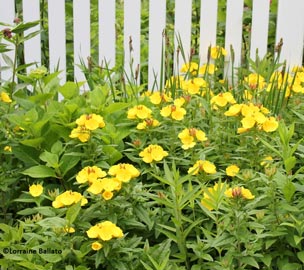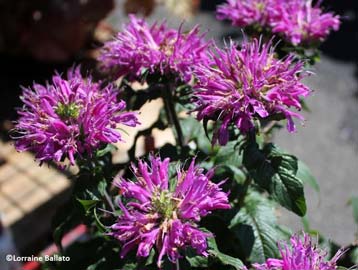There are certain clues that a plant is a garden thug. The first tip is that other gardeners have a lot of it. Ask yourself: why? There must be a reason. Then there are catalog descriptions like, “…fills in quickly…” or “…soil can be poor to average…” Get those antennas up!
 Sundrops (Oenothera)
Sundrops (Oenothera)
© Lorraine Ballato
After the glorious explosion of spring flowers, many gardens quiet down for a week or two until the peonies and Siberian irises kick in. That quiet time would be dull if it wasn’t for the cheerful yellow flowers of sundrops (Oenothera). Except that they show up in so many more places than you remember planting them and in greater quantity. But the deer don’t like them and they pull up easily enough when you yank them. No need to worry that you won’t have enough next year since the ones you leave will self sow in the most unexpected places.
 Bee Balm (Monarda)
Bee Balm (Monarda)
© Lorraine Ballato
Then there is bee balm (Monarda): such a great plant – or is it? It comes in shades of pink, purple and scarlet, draws hummingbirds, and butterflies, tolerates shady and moist conditions and the deer avoid it. It easily fills in those empty spaces nicely but it multiplies rapidly. Therein lies the problem. Pretty soon, it’s popping up seemingly everywhere as it runs underground. Unfortunately, it's prone to develop powdery mildew, an unsightly fungal disease. Know if you have bee balm you’re possibly signing up for a garden chore to keep the disease at bay. Do you really want that? Fortunately, there’s an easy solution to this one - just make sure you get one of the newer cultivars that are resistant to powdery mildew and be vigilant.
It must be said that these thugs are in the garden because of their worthiness: adaptability to rugged conditions, low maintenance, etc.
How to tame these bullies? Just remove the flower heads as soon as they have finished blooming and you’ll go a long way to limit seedlings next year. Think black-eyed Susan (Rudbeckia) and coneflower (Echinacea). Leave a few seed heads for the birds and remove the rest.
Deprive them of ideal conditions, i.e., extra fertilizer or water. Put them in your worst garden areas where nothing else does well: hot and dry areas where the ground seems like cement or the dry shade under the maple tree. Spoiling them will turn them into true invasives. Tough love is the only way to go.
Plan on pulling out new shoots each spring. If you feel generous, pot up those pulled stems with roots and donate them to your local garden club for their next fund raiser. They’ll enthusiastically thank you. In fact, many garden clubs will come and do the digging for you, spring and/or fall. A quick phone call to your local contact can get that question answered.
If you must have a rampant plant, and don’t want to tame it each year, plant it in a pot with the bottom cut away and plant the pot up to the rim. Or plant the thug in a contained area.
One last thought. Come fall when we’re all digging and dividing, beware of gardeners who press their extra plants on you. Think of it like locking the car at night during zucchini season. If other gardeners have too much of something, it’s likely that before long, you will too.
by Lorraine Ballato, Garden writer and author